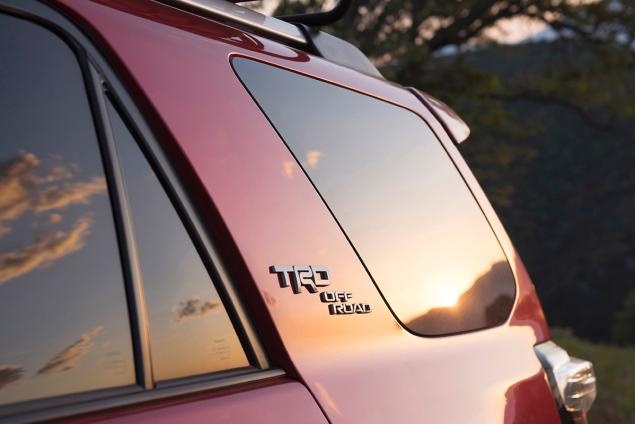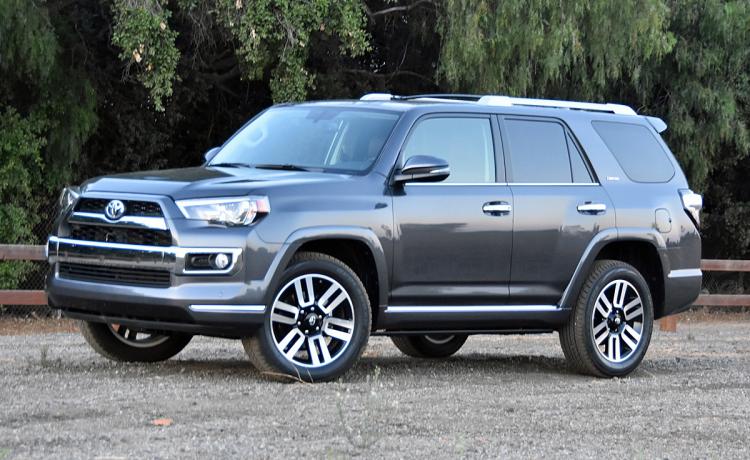
Looking the part of a capable off-roading SUV, the 2017 Toyota 4Runner Limited has a chrome-dipped face and big 20-inch wheels.
Nothing screams adventure quite like a 2017 Toyota 4Runner. One of the few truck-based, body-on-frame SUVs left, the 4Runner is built for serious off-roading rather than suburban shuttling. More refined than a Jeep Wrangler, larger and more accommodating than a Jeep Grand Cherokee, and more affordable than a Volkswagen Touareg or any full-size SUV, the 4Runner offers a strong value proposition to a specific type of person.
That last part is important: a Toyota 4Runner isn’t for everybody. It rides like a truck, it guzzles fuel like a truck, and it handles like a truck. But then, these qualities are a part of its undeniable charm. Authenticity is alluring, and the 4Runner isn’t trying to be anything but a traditional sport/utility vehicle built to go just about anywhere at just about any time.
FOLLOW DAILY NEWS AUTOS ON FACEBOOK. ‘LIKE’ US HERE.
Crossover SUVs like the Toyota Highlander are inauthentic. They are station wagons masquerading as SUVs, some more successfully than others. They are poor substitutes for the minivans that many people refuse to choose for reasons of vanity. Yet crossovers are seemingly devouring the world, making the comparatively slow and unrefined 4Runner even more appealing…to a specific type of person.
Daily News Autos editor Christian Wardlaw and his wife, contributing writer Liz Kim, are married with children. They don’t tow anything. They don’t camp anywhere. They don’t hike or bike. They don’t ski or snowboard. They don’t need 4-wheel drive or lots of ground clearance. Yet after spending a week driving a 4Runner Limited equipped with 4WD, power deploying running boards, a carpeted floor and cargo mat set, and roof rack cross bars ($46,429 including the destination charge of $960), one of them likes the 4Runner while the other doesn’t.
This is their story…
How it Looks
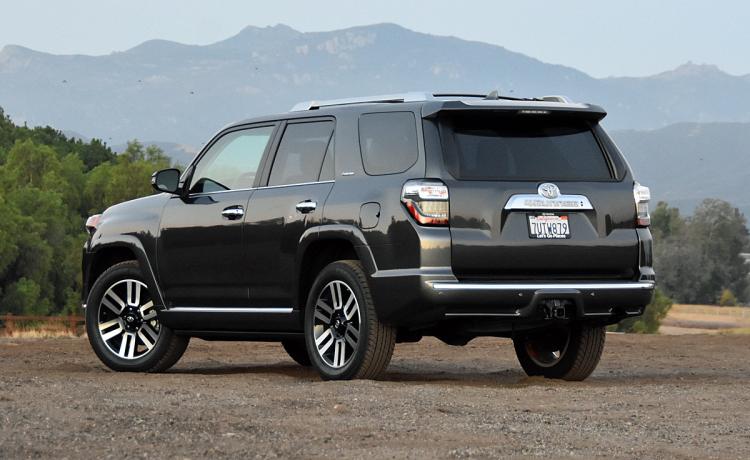
Power the Toyota 4Runner’s rear window down, open the sunroof, lower the side windows, and you’ll enjoy flow-through ventilation and exposure to the outdoors that makes this SUV feel like a convertible.
(SPEEDY DADDY MEDIA, INC.)
She Says:
Right away, I take issue with your wholesale dismissal of crossovers in this review’s introduction. You’re talking about them as if they are inherently inferior, as if only those vehicles that have a singular purpose have an insurmountable advantage.
Crossovers were created to meet a need. People want a vehicle that gives them the ability to throw sporting equipment, shopping bags, camping gear, or anything bulky into the back, but also want something that’s easy to live with, fuel-efficient, and sometimes even fun to drive. They fit the needs of many families, and it stands to reason that their ever-growing popularity is more than just a fad.
Yes, minivans are always going to offer more room and utility, but some people just don’t like them. It may be due to their image, and it may be for some other reason. Fanny packs and cargo shorts are functional and utilitarian too, but I don’t see you wearing them.
He Says:
This may horrify you, but yes, I do have some cargo shorts. And I wear them. They’ve got lots of pockets. With zippers. And Velcro. Very useful.
She Says:
Yes, but at least you don’t load them down with keys and such and make them bulge and sag. Rather, you ask me to hold your sunglass case and keys in my purse.
Here’s the thing: Many people still use the terms SUV and crossover interchangeably, even though they are two completely different animals. And they serve different lifestyles.
As an automotive journalist, it is important to subjugate personal preferences and evaluate vehicles based on the purpose and audience for which it is built. But because there are many people who don’t know the difference between car-like unibody and truck-like body-on-frame construction, for the purpose of this review, I’m going to evaluate it through the lens of my own personal lifestyle, which is that of a suburban mother of two, with few fantasies of adventuring off-road.
He Says:
So, umm, are you planning to talk about the 4Runner’s design at all?
She Says:
Yeah, yeah, I’m getting to that. I was never crazy about this SUV’s 2014 facelift. Still, the chrome-heavy look of the Limited is preferable to the strange faces worn by other 4Runner variants. Our test vehicle’s 20-inch wheels also gave the 4Runner Limited a more street-savvy look.
Step inside and you’ll find that the design is utilitarian all the way, with no additional ornamentation or curves to spiff up the place. It’s all straight lines and right angles. I liked the nice, smooth perforated Redwood leather upholstery, as it breathed a whiff of color and warmth into an otherwise black and grey cabin. But the plastic wood? Bless your heart, Toyota, but why bother?
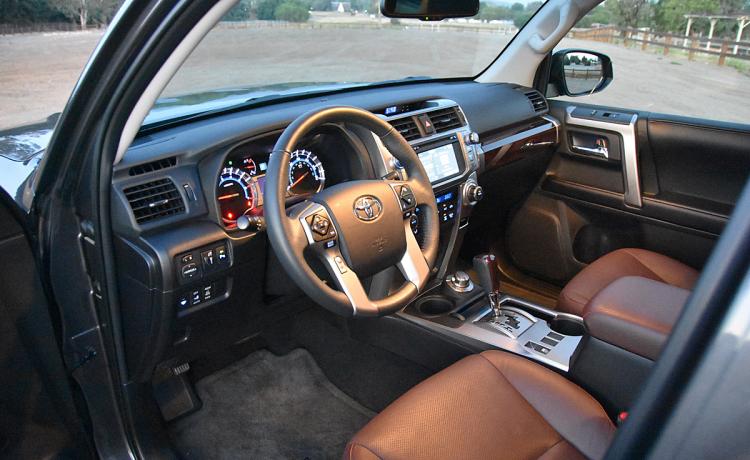
Fake wood, silver trim, and Redwood brown leather seats dressed up the 4Runner Limited’s interior.
(SPEEDY DADDY MEDIA, INC.)
He Says:
Good looks do elude the Toyota 4Runner. Depending on the trim level, front styling is different between the SR5, the TRD Off-Road, the TRD Pro, and the Limited. None of them is attractive, and our Limited model’s extra chrome trim gave it a grimace similar to a teenager’s after an expensive trip to the orthodontist.
Nevertheless, the 4Runner’s pugnacious face suits its rugged personality. This SUV actually looks better wearing a layer of dust and dirty tire crust. Scrapes, scratches and miscellaneous battle scars are badges of honor, clear evidence that the truck’s owner uses it as God and Toyota intended.
The rest of the 4Runner is appealing to me, displaying appropriately industrial design cues. In profile, the brick-like SUV is chiseled and muscular, the Limited model’s handsome 19-inch wheels filling the wells. The squared-off roofline ensures maximum cargo capacity and utility, and around back the liftgate’s power rear window is a feature that I wish more automakers offered.
Inside, our test vehicle’s beautiful Redwood leather contrasted sharply with an otherwise black cabin, creating a rich, upscale look. Simulated wood trim is present to remind the owner that they’re driving the Limited model, and the majority of the materials exude quality and attention to construction detail. Don’t look for anything fancy here, though, as the 4Runner’s interior is all about functionality.
Summing up, the 4Runner’s styling contributes significantly to its authenticity. It might be ugly on the outside, and it might emphasize function over form on the inside, but these are reasons to like it rather than dismiss it.
How it Feels
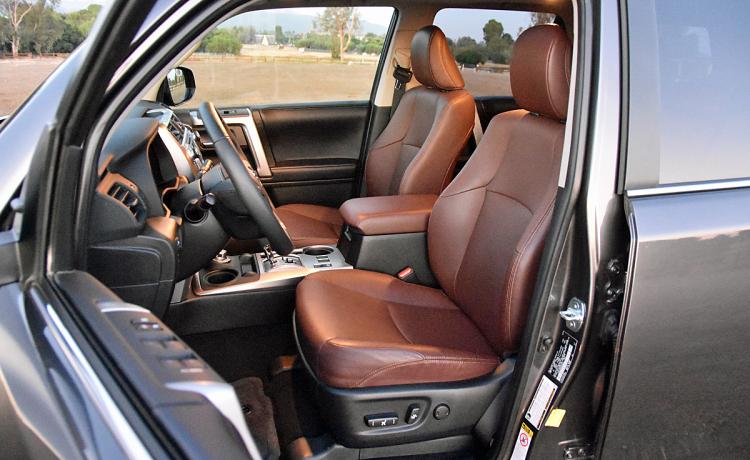
Optional power deploying running boards make it easier for shorter people to climb inside of the 4Runner, where each of five passengers will fine comfortable accommodations.
(SPEEDY DADDY MEDIA, INC.)
He Says:
A 4Runner offers plenty of room for five adults, and everyone enjoys a comfortable seat. Kids and shorter people might have trouble climbing aboard, but our Limited test vehicle had the optional power retractable running boards that tuck up under the rocker panels when they’re not in use. Toyota offers an optional third-row seat for the 4Runner, but it is quite cramped, is mounted far too close to the tailgate, and chews into nearly all of the available cargo room.
As you might expect, the driving position is commanding, and the driver grips a thick, oversized steering wheel. Outward visibility is excellent as long as you don’t mind how far away the relatively vertical windshield is, and how the roof blocks visibility of overhead traffic signals if you pull too close to an intersection.
Our test vehicle also had heated and ventilated front seat cushions and seat backs. If you live someplace where it is frequently hot, you’re going to love the 4Runner for its ice-cold air conditioning and some of the most effective seat ventilators I’ve ever experienced. For cold-weather dwellers, I can only assume that the heating system is just as effective.
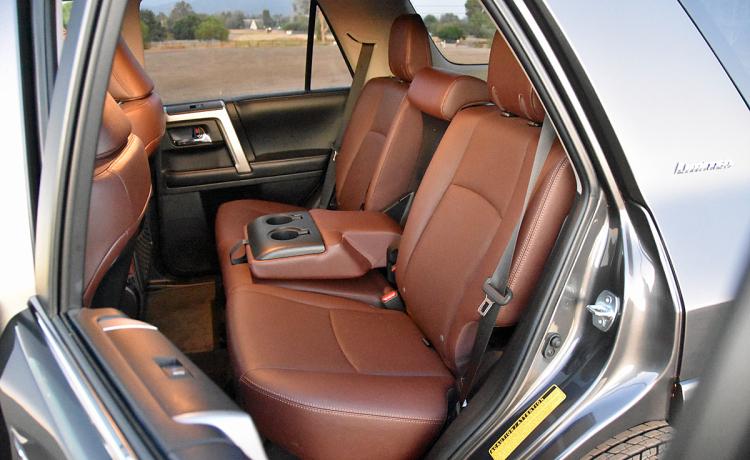
You can legitimately carry five people in the Toyota 4Runner. A third-row seat is an option, but it sits too close to the tailgate and virtually eliminates cargo space.
(SPEEDY DADDY MEDIA, INC.)
She Says:
There is no such thing as plush in the 4Runner’s vocabulary. The majority of the cabin’s surfaces are hard, meant to take a beating. Not necessarily cheap or brittle, mind you, but chosen with durability and easy cleaning rather than comfort or tactile pleasure in mind. Everything is well fitted and assembled, and you can easily imagine yourself bouncing down a rocky path 20 years from now, the cabin looking much like it did when new, little worse for the wear.
From a front passenger’s perspective, the view out is indeed commanding, but the seat is mounted pretty low and there’s no seat height adjuster. Even with my short legs, that means that I was practically sitting on the floor, and without much thigh support. The air conditioning and seat ventilation systems were indeed chillingly effective, though, and much appreciated during hot and sunny weather.
How it Works
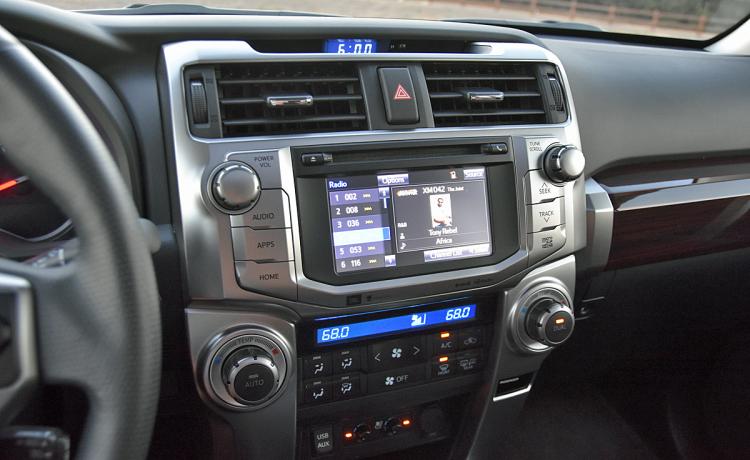
One of the worst things about the 2017 Toyota 4Runner is its Entune infotainment system.
(SPEEDY DADDY MEDIA, INC.)
She Says:
Basic, straightforward, and simple, the 4Runner’s controls are old school but fit the SUV to a T. Large, useful knobs for stereo volume and radio tuning are much appreciated, and they’re even well articulated, making them easy to use even while wearing gloves.
Like the controls, the infotainment system is basic and old school, too. The tiny, 6.1-inch touchscreen with its low-resolution display is like something that Leapfrog might have made eight years ago. But the voice commands work surprisingly well.
Hey, remember the granddaddy of today’s 4Runner? More than 30 years ago, it was little more than a pickup truck with a fiberglass top. What was practical and useful back then has been handed down through the ages, and the current 4Runner’s cargo space exceeds most other midsize SUVs.
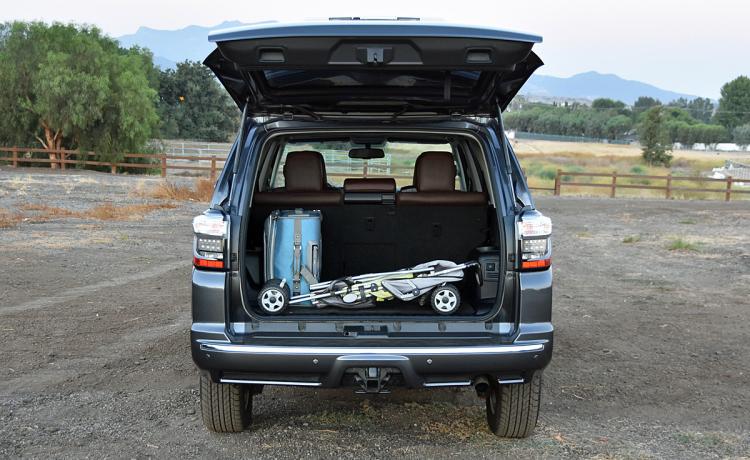
Behind the 4Runner’s rear seat, 47.2 cubic feet of cargo space awaits. Maximum cargo volume measures 88.8 cu.-ft. with the rear seats folded down.
(SPEEDY DADDY MEDIA, INC.)
He Says:
What I love about the 4Runner’s interior, aside from the amount of space and the super-comfortable seats, is the control layout. Huge, oversized knobs and huge, oversized buttons make it easy to find and use most of the SUV’s features, though the overhead controls are not as easy to reference, especially while driving.
Displays are a mixed bag. Clearly rendered Optitron instrumentation provides speed and fuel level to the Limited’s driver with no more than a glance. Unfortunately, the silver interior trim makes it harder to decipher the low-contrast lettering and icons for some of the 4Runner’s matching silver controls.
Technologically, yes, the 4Runner’s top infotainment system looks increasingly like a relic. For starters, it uses a tiny, recessed 6.1-inch touchscreen display that completely washes out under a variety of lighting conditions. These factors, combined with the 4Runner’s stiff and busy ride, render the screen a source of irritation rather than delight.
Furthermore, because Toyota is concerned about privacy issues, the company does not offer Apple CarPlay or Android Auto smartphone projection. Increasingly, modern car buyers expect this.
At least Toyota makes the system Siri-compatible, and provides accurate real-time traffic and Doppler weather radar overlay for the navigation map. The company’s App Suite technology is also aboard, supplying access to popular apps such as Pandora and Yelp at no extra cost. I also found the voice recognition system to be relatively flexible and civilized.
Cargo space is generous, measuring 47.2 cubic feet behind the rear seat. Fold it down to enjoy an impressive 88.8 cu.-ft. of volume. These numbers exceed most midsize SUVs, and the 4Runner’s generosity is immediately evident the moment you open the liftgate. You can also get a sliding deck cargo floor that makes it easier to load the SUV, and our test vehicle had a handy 3-prong power outlet back there.
How it Drives
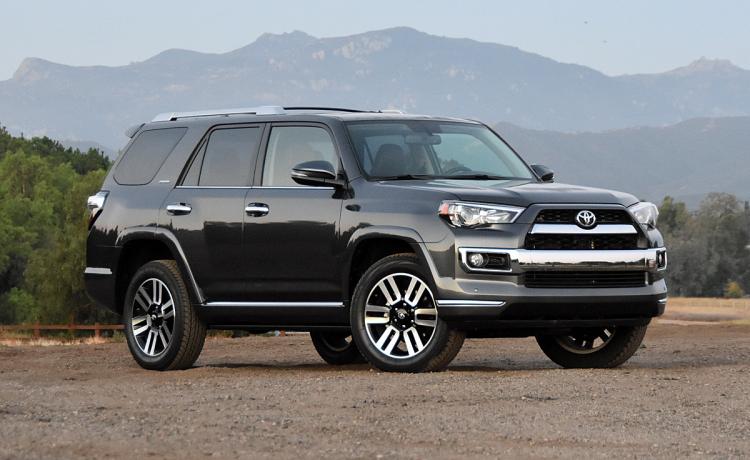
No amount of suspension tuning wizardry can mask the fact that the Toyota 4Runner is, at its heart, a truck and not a car. This is a liability on pavement.
(SPEEDY DADDY MEDIA, INC.)
He Says:
Slow and sloppy best describes the 4Runner’s driving dynamics. In Limited 4WD specification, this SUV weighs a whopping 4,805 pounds, and Toyota expects a 4.0-liter V6 engine to get the job done. Horsepower measures 270 at 5,600 rpm and the 278 lb.-ft. of torque peaks at 4,400 rpm. A 5-speed automatic powers the rear wheels in some models; the Limited we tested had a full-time 4WD system with active traction control and a locking limited-slip center differential.
Acceleration is leisurely at best, but Toyota calibrates the drivetrain to feel punchy at low rpm. Fuel economy is horrific. Though it averaged 17.8 mpg on my test loop, coming in just shy of the EPA’s estimate of 18 mpg in combined driving, if you spend more time in the city and suburbs than on the highway that number will drop fast.
Though the 4Runner is adept at pummeling pockmarked pavement into submission and shrugs off dips, bumps, drainage channels, and driveway aprons like they don’t even exist, on-road handling isn’t a highlight. Limited models get something called an X-REAS sport enhancement suspension and 20-inch wheels wrapped in P245/60 Yokohama Geolander tires, but cornering limits are modest. Though the suspension is remarkably successful at quelling body bob, bounce, and roll, the tires squeal and howl at the slightest provocation.
Heavy steering takes an eternity to respond to input, and the Limited’s 20-inch wheels do the SUV no favors when it comes to making U-turns or when negotiating tight trails. The brake pedal is difficult to modulate, too, though the brakes themselves are effective.
Switching the 4Runner into 4-Hi, I tackled a moderately difficult trail with deep ruts, encroaching brush, and a steeply angled descent. The Toyota took it all in stride, and getting it turned around in a small amount of space proved to be the toughest task.
In the environments where most people drive most of the time, a 4Runner isn’t much fun. There are four ways to best appreciate this SUV’s talents:
- Drive on crumbling city streets, where the truck-tough underpinnings seem impervious to damage
- Blaze a trail, leveraging the 4Runner’s impressive ground clearance and approach, breakover, and departure angles
- Battle a blizzard, getting around town when everyone else is stuck
- Drive along the beach, windows down, sunroof open, and with nowhere in particular that you need to be
That last recommendation illustrates one of the 4Runner’s most endearing characteristics. Power down the side windows and the rear liftgate window, open the sunroof, and you’ll enjoy the same sensation of openness, freedom, and flow-through ventilation as a Jeep Wrangler equipped with a hardtop and removable roof panels.
Driving on Pacific Coast Highway one warm morning, the sea air swirling throughout the cabin and reggae music pouring out of the JBL audio system’s 15 speakers, my stress ebbed away, replaced by calm, cool, and collected reflection.
Can a 4Runner serve as a substitute for yoga? In my opinion, it can.
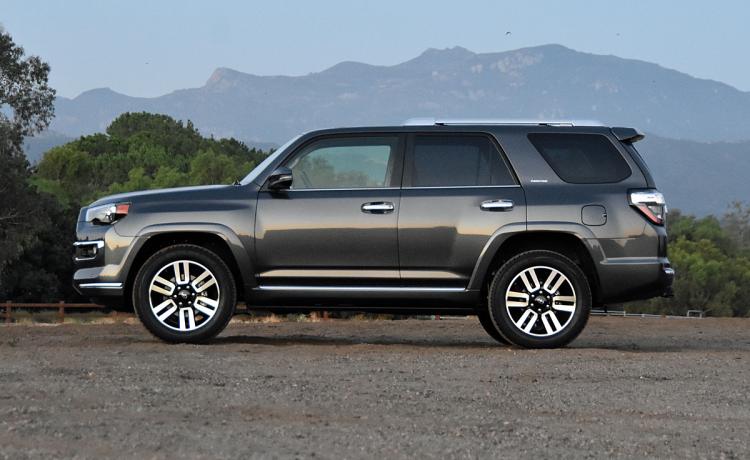
A 4.0-liter V6 engine is the only one available, and it struggles with its workload. Fuel economy is not a 4Runner highlight, either.
(SPEEDY DADDY MEDIA, INC.)
She Says:
Planning on scampering over boulders? Traversing deep ruts? Going where few dare to venture? The 4Runner abides, with talent, strength and 9.6 inches of ground clearance to overcome most obstacles.
On asphalt, however, it cements its reputation as one of the truckiest trucks on the road. Steering is slow, wooden and numb, and its wide turning diameter is a hassle. The suspension can indeed flick off moderate bumps around town, but harshness is transmitted into the cabin.
On a curvy mountain road, you’d better not forget to brake well in advance of a turn to carry only modest speed into corners, as it’s got a tall center of gravity and doesn’t let you forget it. The 4Runner doesn’t quite feel tippy, but you’re not surprised as to why it gets only a 3-star rollover resistance rating from the NHTSA.
The engine is adequate, with grainy and loud power delivery accompanied by underwhelming mid-range thrust. Once the 4Runner is up to freeway speeds, the V6 simmers down and becomes almost refined. Perhaps Toyota should offer the 301-horsepower V8 engine from the Lexus GX as an upgrade for people who prefer a little more zip in their trips.
If you are used to driving trucks and enjoy them, you will probably love the 4Runner’s dynamic characteristics. Having tested a succession of crossover vehicles prior to the 4Runner’s arrival, the differences between the truck-based, tall, and heavy traditional SUV and the car-based, low, and light CUVs was a stark one. For my own personal use, I definitely prefer a crossover.
On a side note, I really hope that people who opt for the Lexus GX 460, which is basically a tarted-up 4Runner with a V8 engine, realize that they’re not getting into a bigger, plusher RX by choosing it. If that is their expectation, they will be mightily disappointed.
Would we buy one?
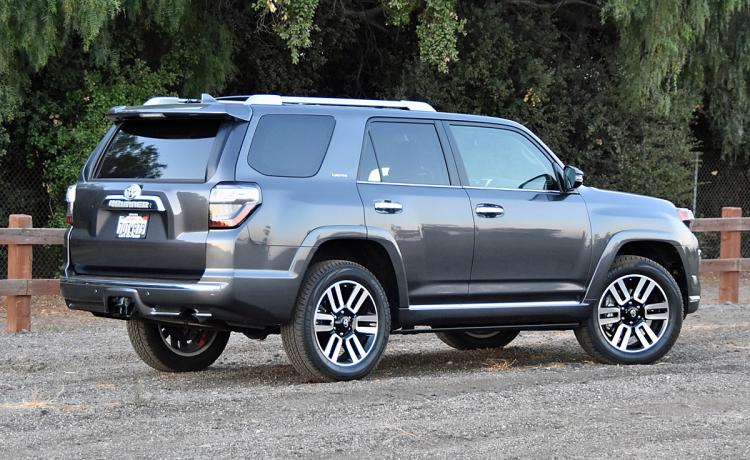
Undoubtedly, the 4Runner is an appealing choice is a world overrun by crossovers. But until it improves in terms of crashworthiness, it can’t serve as credible family transportation.
(SPEEDY DADDY MEDIA, INC.)
Her Verdict:
Having been a Southern California girl almost my entire life, the prospect of a catastrophic earthquake is never too far from my mind. You know, the kind that might involve crumbled roads, rising waters and possibly a rescue by Dwayne Johnson. Zombies might even show up.
In such a scenario, it would be helpful to have an SUV like the Toyota 4Runner. It is of the few “survivalist” midsize SUVs left. (Actually, in this fantasy scenario, I would be setting off in a Range Rover.)
A 4Runner could also prove necessary if your life includes snow measured in feet, or your everyday vocabulary includes phrases such as “ground clearance,” “tow rating,” and “angle of departure.” You might even consider this Toyota something to be desired. It sure helps that the 4Runner is built to last, and enjoys a strong reputation for reliability and durability. It may be expensive, but history also shows that it will probably retain its value very well.
Here’s the thing, though. The qualities that make the 4Runner so impressive off-road are exactly the ones that make it unimpressive on pavement, the city streets, suburban boulevards, high-speed freeways, and winding country roads on which you spend the majority of your time. A handful of vehicles are able to combine robust off-road capabilities and athletic on-road prowess, but unless you’re willing to try a Jeep Cherokee Trailhawk or a Volkswagen Touareg, you’re going to spend significantly more money to get it in the form of a Range Roveror a Porsche Cayenne.
The Toyota 4Runner is built for traveling far off of the beaten path, and while it is indeed useful and practical, our family cares little about searching for lost treasures or exclusive adventures in the remote corners of the world. And that means we will stick to car-based transport for superior on-road performance and handling.
His Verdict:
Though I have no use whatsoever for a vehicle like a Toyota 4Runner, it sure does appeal to me.
Maybe it’s a guy thing, related to the 4Runner’s studly styling. Maybe it’s a practicality thing, related to the roomy interior and huge cargo area. Maybe it’s a vanity thing, related to a romanticized notion of myself as a valiant explorer seeking adventure and not a desk-bound, overweight suburbanite. Maybe it’s a convertible thing, related to my love of open-air driving.
Realistically, I know the 4Runner is not for me. I genuinely love driving, and the 4Runner is fun only under specific circumstances. The gas mileage is awful, too. And the infotainment system needs a significant upgrade.
The deal-breaker, though, is that the 4Runner gets mediocre crash-test ratings. The 3-star frontal impact rating for the front seat passenger, the 3-star rollover resistance rating, and the “Marginal” small overlap frontal offset collision rating for the driver make the 4Runner a non-starter for a family vehicle, no matter how you’re planning to use it.
